You are not logged in.
- Topics: Active | Unanswered
#676 5 Jun 2021 8:40 pm
- Bergen_Guy
- Member
- Registered: 6 Feb 2020
- Posts: 353
Re: Waterlust sailing canoe in Norway
If you search for “Hardanger båt og fiske“ on Facebook you will see a video of the first few minutes of our sail! As it’s Facebook I have no idea how to link to it…
Offline
#677 5 Jun 2021 11:44 pm
- spclark
- Member
- From: "Driftless" Wisconsin USA
- Registered: 19 Mar 2020
- Posts: 478
Re: Waterlust sailing canoe in Norway
...I was out sailing today for the first time with the outriggers. Well, a great success, they really add to the boats capabilities. Sadly they also add to the weight and to the rigging time, but that’s life.
Outstanding Guy, no reefs yet an 'unexcited' turn at the helm! Yes to the additional weight but at least it contributes I think more than a similar weight placed in the main hull?
Have you weighed the aka/ amas package separately? The shipping weight for the kit itself is around 43 lbs / 19.6 kg so I'd guess the finished weight might be what, ~ 30-35 lbs. / 14-16 kg? For 70 lbs / 32 kg added displacement out there where it does a great deal to stabilize an an otherwise unloaded 'vaka'.
If you search for “Hardanger båt og fiske“ on Facebook you will see a video of the first few minutes of our sail! As it’s Facebook I have no idea how to link to it…
This the same video you'd put up on Youtube? I 'disappeared' my F*book account early last year so I'm of no help w'that.
As for my project: I have the rub strips ready for epoxifying before they're stuck to the sheerstrakes of my hull. Have the 3/4" bonding area masked off in preparation for sanding off the primer/paint layer. Will get on to that sanding after I finish this post. Might just get those strips bonded before I go back to work Wednesday; it's warm enough here these days (92°F today! 33.3 °C) for slow hardener to work really well!
Looking forward to hearing what Chuck has to say once he's got back to shore!
Last edited by spclark (5 Jun 2021 11:51 pm)
Offline
#678 6 Jun 2021 6:17 am
- MartinC
- Member
- Registered: 3 Apr 2020
- Posts: 345
Re: Waterlust sailing canoe in Norway
Well done Guy! Lovely job of those outriggers and Svale sails really well with them. Looking at your (beautiful) sailing area, I can see that they are essential for single handed sailing out there.
(Also very impressed by your ability to sail a Waterlust and film at the same time!).
I would gues that without the Hobie Drive well, Svale must be the fastest Waterlust in the world.
Offline
#679 7 Jun 2021 8:05 am
- Bergen_Guy
- Member
- Registered: 6 Feb 2020
- Posts: 353
Re: Waterlust sailing canoe in Norway
Thanks Martin! Yes - she does fee a lot more like a vessel suited to these waters. I am now looking forward to heading out with more of a focus on the sailing and the places I see than wondering if I will get wet. Here are a few more snaps! I must make an effort and get some good sailing photos from outside the boat at some point.
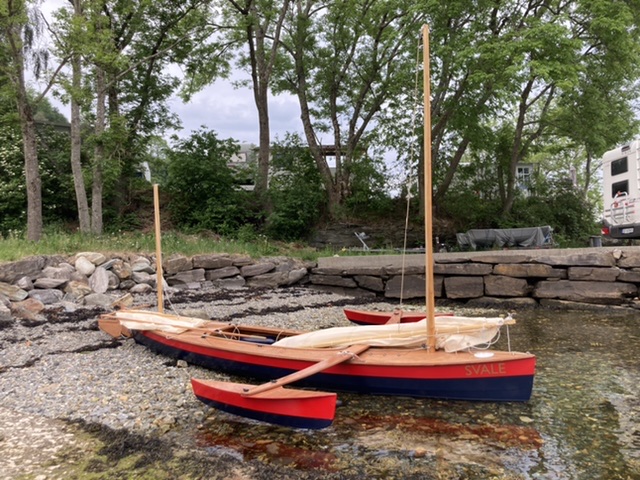
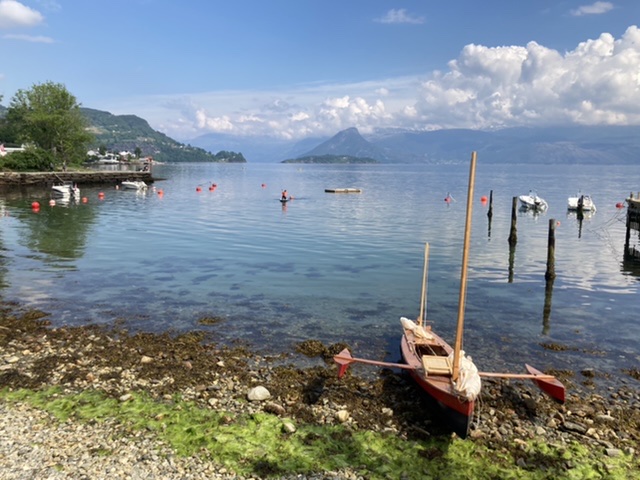
Offline
#680 7 Jun 2021 11:01 am
- spclark
- Member
- From: "Driftless" Wisconsin USA
- Registered: 19 Mar 2020
- Posts: 478
Re: Waterlust sailing canoe in Norway
Very nice Guy! Yes it would be a good thing to have more pics of Svale under sail once you can manage that. Beautiful country you have there.
(Do you have your seat resting on the bottom when under sail or did you find a need to raise it? Jeff's added 4" to his for using with a Mirage drive. I'm planning on building a mount that rests on the longitudinal stringers myself but for sailing maybe do entirely without, keep my body lower while also facilitating changing positions if needed.)
Offline
#681 7 Jun 2021 12:03 pm
- Bergen_Guy
- Member
- Registered: 6 Feb 2020
- Posts: 353
Re: Waterlust sailing canoe in Norway
I have my seat on the bottom (I use a folding seat that I got from Fyne) - which is very comfortable. Overall it’s great if you don’t have to get out of it quickly. Before having the outriggers I was thinking of making a deck level seat/platform so that I could sit on the centreline without having to get ‘down’ into the boat, or sit on the aft deck, which is a bit far back for good trim. The main thing was that it’s not so easy to get from low down in the middle, to up on the side deck quickly, but with the outriggers that quick move isn’t needed from my impressions over the weekend.
There is a bit of video online from outside the boat, that’s on the Facebook page i mentioned above - worth a look if you can find it!
Offline
#682 7 Jun 2021 2:16 pm
- Chuck
- Member
- Registered: 24 Nov 2020
- Posts: 138
Re: Waterlust sailing canoe in Norway
Guy, your pictures are fantastic! Do you work for the Norwegian tourist agency?
No luck with me getting the boat out on Sunday (even though the wind looked great). I did manage to drive 12 hours up to DC Saturday without any problems (that I can see yet), although I did find that the turbulence coming off the back of the big rigs on the highway extends back a lot further than I thought as I saw Whimbrel up top bucking around a bit as I passed trucks...
I did manage to get almost all the rigging up yesterday and hope to go out this afternoon! I'll post with the results and hopefully photos.
Offline
#683 8 Jun 2021 4:51 am
- MartinC
- Member
- Registered: 3 Apr 2020
- Posts: 345
Re: Waterlust sailing canoe in Norway
Had a great sail yesterday and Gaia performed excellently with her new smaller rig and heavy daggerboard. Wind up to 10mph and no need to change position from the pedaling position (sitting on an inflatable canoe seat on the floor). As the boat heeled, the main automatically spilled the wind and she self-righted. Points to note :-
1. I agree with Guy about the tendency to get stuck 'in stays' when going about. Tacking needs a bit of a run-up and the mizzen must be released. On narrow parts of the river I found it easier to pedal through the tack.
2. The mizzen must not be over tightened. She sails much better with it full rather than flat, and all flattening does is cause her to heel.
3. You need to have the mizzen sheet cleated in a handy position, as in a gust, I think it is the mizzen which will cause you to heel, round up and ultimately capsize rather than the mainsail. It takes a bit of practice as you are running out of hands with the tiller, mainsheet and mizzen sheet all requiring attention. (I am in awe of Guy who manages to take a movie at the same time as well!).
4. Because of the dominance of the mizzen, with my rig, if the wind gets up I shall scandalise the mizzen sail (which I can do from a sitting position). Those of you with the normal rig might find it better to do the same rather than putting a reef in the main? I would be interested to hear your views.
Offline
#684 8 Jun 2021 8:55 am
- Bergen_Guy
- Member
- Registered: 6 Feb 2020
- Posts: 353
Re: Waterlust sailing canoe in Norway
Martin,
That's wonderful news! I am very happy that Gaia is now performing as you want. I think once we get these boats dialed in for our various purposes, they have the potential to be really super boats. I agree that the mizzen does impact on the balance going upwind, and I also agree that in general neither of the sails should be over sheeted.
With the full main, I don't find that the mizzen tends to round the boat up in gusts on Svale, but then I have not sailed so much with a reefed main, which might match your rig more closely in terms of balance between the sails.
I am a big fan of scandalising sails when things are getting too exciting though, so that sounds like a very good plan.
I like the sounds of being able to 'motor' round the tack with the mirage drive. I have found that a single canoe paddle works find as an auxiliary for me, so long as I am not going too far. For paddling away from a beach, or getting round a tack or whatever, it seems to the job nicely and is easy to stow. With the dagger board and rudder down she tracks nicely without me having to change paddling sides all the time, which is not the case without the foils. (I am not a canoeist - I think there are clever paddle strokes one can use to keep things tracking nicely, but I have yet to master them!)
Last edited by Bergen_Guy (8 Jun 2021 8:55 am)
Offline
#685 10 Jun 2021 10:50 am
- MartinC
- Member
- Registered: 3 Apr 2020
- Posts: 345
Re: Waterlust sailing canoe in Norway
Yes. The Waterlust really is a remarkable boat and lovely to sail and peddle!
I went for a 'light airs' sail yesterday and was able to experiment more with the rig and sailing seating position.
I love having the mizzen, but I am more than ever convinced that the least you have to do with it the better. I raise mine before launching and scandalise it so when underway I mearly have to release one rope and it's down. Pull on one rope and its up and out of the way.
As over-sheeting is a concern for me (see my last post), and turning round to see if the sail is setting correctly is a pain, I have now decided that as Gaia is not a performance boat, I only need 3 mizzen sheet settings; close hauled, beam reach and running. I have therefore three loops in the sheet and I can see what the sail is doing from these without turning round. It seems to me that with such a small sail any greater adjustment is unnecessary.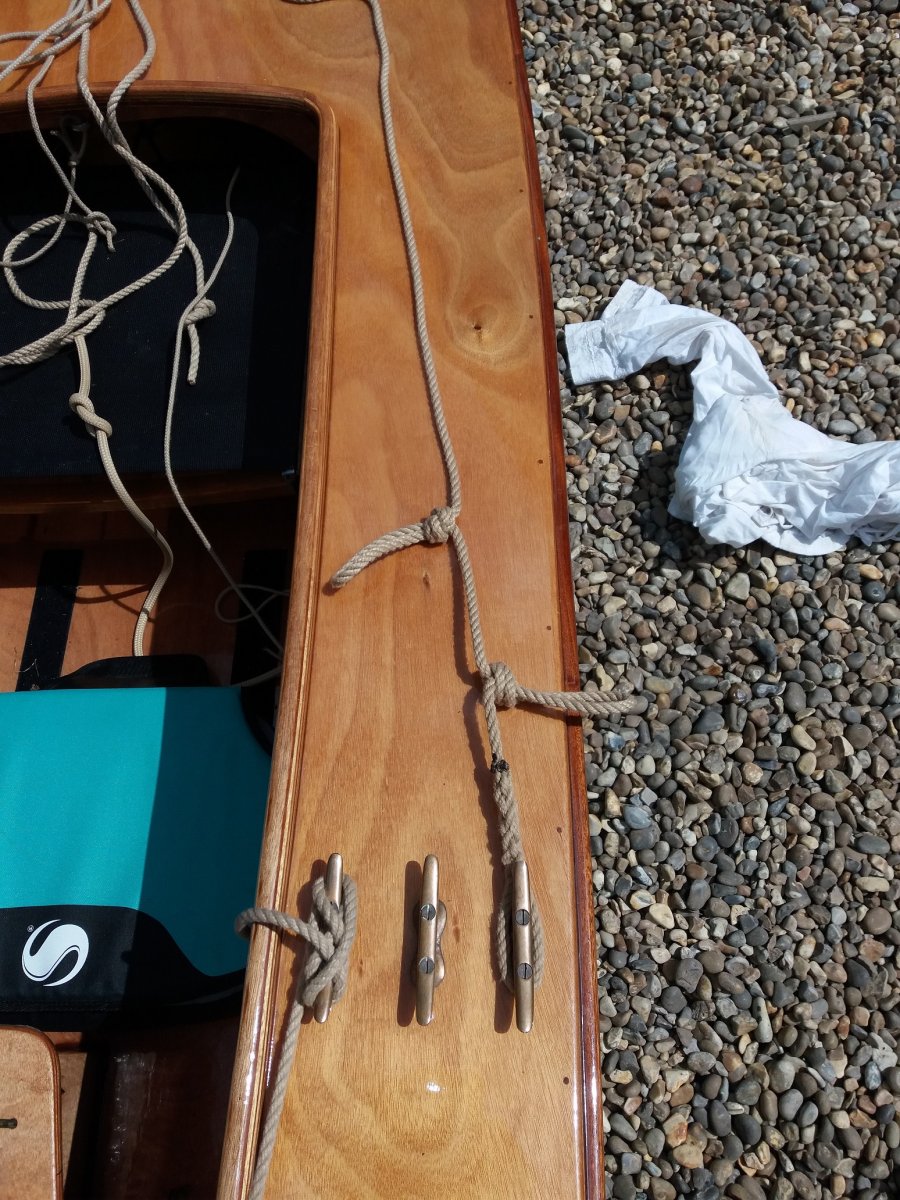
Offline
#686 10 Jun 2021 8:01 pm
- Chuck
- Member
- Registered: 24 Nov 2020
- Posts: 138
Re: Waterlust sailing canoe in Norway
On the height of the Mirage drive: I was at the REI a couple of days ago and saw a Hobie kayak on display with a Mirage drive. I took a look to see the height of the seat with respect to the drive, and estimate that the seat is 12" above where the deck would be on the Warterlust.
Offline
#687 10 Jun 2021 8:34 pm
- MartinC
- Member
- Registered: 3 Apr 2020
- Posts: 345
Re: Waterlust sailing canoe in Norway
Yes. Your feet are quite high in relation to your bottom when sitting in the Waterlust, but the position is quite comfortable as long as you have sufficient back support. My kayak seat has about 4" of inflatable cushion velcro'd to the floor. You can see the back flipped down on the photo above.
I peddled for at least an hour yesterday and haven't suffered today - more than I could say for an hour on the bike!
Offline
#688 11 Jun 2021 7:11 am
- Bergen_Guy
- Member
- Registered: 6 Feb 2020
- Posts: 353
Re: Waterlust sailing canoe in Norway
SP - I see that I failed completely to respond to your question regarding weights and righting ability - I do apologize!
I have not weighed them or the cross beam, the hulls themselves are light, sufficiently light that I can lift one in one hand. The cross beam is heavier, but not sufficiently so that it's a nuisance to carry around. I think the extra righting moment is really rather large, I guess this has a lot to do with how far out from the main hull the outriggers are. I am not sure how large a weight within the hull one would need to get a similar righting moment, but I suspect it's very large indeed, as these weights would always be close to the center line, so I suspect that most of the increased righting moment would come from increased displacement, rather than to the righting moment itself, which I guess only really comes to play as the boat is more and more heeled over. I guess one advantage with the outriggers is that they already have their buoyancy on the end of a long lever as soon as the hull starts to displace water, so the righting effect kicks in really quickly.
I guess the down side is if one manages to heel the vessel over sufficiently that the outrigger hull actually submerges, then it's righting moment could start to decrease the more it is pushed under water as the outrigger hull gets closer to the centre line as it heels more. The other issue, which I believe is common to all multi hulls, is that the hull might be inclined to be rather stable upside down if one did manage to flip it over. I feel this would be a good test for a sunny day!
Did you manage to get your rubbing strips epoxied on SP?
Offline
#689 11 Jun 2021 7:51 am
- MartinC
- Member
- Registered: 3 Apr 2020
- Posts: 345
Re: Waterlust sailing canoe in Norway
For your peace of mind Guy, I raised the question of a 180 degree capsize with Dillon when he was designing the outriggers and he assured me that it was uppermost in his design considerations. That said, I think there is a prescribed technique for righting a totally inverted catamaran (different to a monohul), which I saw on one of the sailing canoe websites. It might be worth studying this before you take the plunge!
Offline
#690 11 Jun 2021 7:57 am
- MartinC
- Member
- Registered: 3 Apr 2020
- Posts: 345
Re: Waterlust sailing canoe in Norway
https://www.songofthepaddle.co.uk/saili … 38740.html
This was the one.
Offline
#691 11 Jun 2021 8:43 am
- Bergen_Guy
- Member
- Registered: 6 Feb 2020
- Posts: 353
Re: Waterlust sailing canoe in Norway
Thanks! I will take a look - I see Solway Dory also have an article and a few photos showing how things work with their boats when they have outriggers fitted!
Offline
#692 11 Jun 2021 11:19 pm
- spclark
- Member
- From: "Driftless" Wisconsin USA
- Registered: 19 Mar 2020
- Posts: 478
Re: Waterlust sailing canoe in Norway
SP - I see that I failed completely to respond to your question regarding weights and righting ability - I do apologize!
No need for one!
I'm not getting e-mails about new posts so I check in here every few days just to stay up with progress reports.
I think the extra righting moment is really rather large, I guess this has a lot to do with how far out from the main hull the outriggers are.
Yep, leverage. Just as with sail area and longer spars. Mike Waters' alternative scheme had longer amas on shorter akas (two, both pivoting thus more complex) to provide a similar righting moment as with Dillon's design.
I am not sure how large a weight within the hull one would need to get a similar righting moment, but I suspect it's very large indeed, as these weights would always be close to the center line, so I suspect that most of the increased righting moment would come from increased displacement, rather than to the righting moment itself, which I guess only really comes to play as the boat is more and more heeled over.
Think of a pendulum. Tends to want to center itself unless energy is added to keep it swinging. Same principal at work I think.
Or those outrageous pivoting keels on the AC10 boats: hull heels but the keel stays mostly perpendicular to the water's surface.
I guess one advantage with the outriggers is that they already have their buoyancy on the end of a long lever as soon as the hull starts to displace water, so the righting effect kicks in really quickly.
(My plans include tying an empty plastic milk or bleach bottle to the main mast top when I go out for the first few times until I get some sense of how touchy the craft is to heel, just in case! The added buoyancy so far out on the mast top should help prevent a 180°.)
I guess the down side is if one manages to heel the vessel over sufficiently that the outrigger hull actually submerges, then it's righting moment could start to decrease the more it is pushed under water as the outrigger hull gets closer to the centre line as it heels more. The other issue, which I believe is common to all multi hulls, is that the hull might be inclined to be rather stable upside down if one did manage to flip it over. I feel this would be a good test for a sunny day!
If the sails are up I don't think the chance of a complete 180° is too likely. The spars and sails would resist immersion when the sunk ama's at the low point, while the hull itself ought to stay fairly high in the water on its side. Even swamped the air chambers at each end should manage to allow the hapless skipper to get things righted though perhaps after dousing the sails. You've experienced trying to right a capsized hull only to have it go a full 180° from swamped port to swamped starboard so the intertia effect of the wet sails is overcoming whatever righting moment you've induce standing on the daggerboard.
Jeff did mention there were times in his Florida 120 a couple weeks back where an ama was entirely submerged so it can happen but he said it didn't materially affect stability or his speed, so there's that. Cats are a different animal entirely; their amas are usually almost as long as the vaka between so righting moment's more precarious once they begin to get the windward ama out of the water. Pitch-poling can happen pretty quickly, induced by the increase in resistance of the submerged ama.
Did you manage to get your rubbing strips epoxied on SP?
Not quit yet, no. Got both epoxied (one coat on bonding surface, two coats on outsides) but need to add a bit more where cleaning up the overage got out of hand & I exposed bare wood.
My friend of 50 years is headed up from Florida, should be here next weekend. He taught me to sail back then, expects to help christen 'Nora Jane' while he's here, even if only under Mirage power. So now that my work week's done I have four days to get the hull ready. List of things to do: mount rudder hardware, mount rudder to cassette, make and rig tiller; build support for cane seat to get it sitting higher than on floor alone, rig some means to hold it in position (Jeff's got a neat cordage arrangement he's sent pics of I might 'borrow'); bond 4 inspection hatch rings to deck & drive box cover; add registration decals; tighten all the bolts holding my trailer together (it was a kit); pick up upgrade 13" wheels with 145mm radials (out for balancing this week) tomorrow morning)... prolly more but those are the major tasks. Maybe get the toggles finished so I can secure the stowage hatch rather than just taping it sealed to the deck.
Keep up the reports! I'm loving every one I read! Hope I can contribute something meaningful once I get Nora Jane launched then the sailing rig fitted. Ama's likely will be next winter's project.
New today:

I picked up the new 12" wheels this morning, got two of 'em onto the trailer's axle. The extra 2" height allows me to remove the 5" x 12" timbers I'd had the trailer wheels sitting on for 18 months. Now there's enough axle-to-ground clearance for the timbers to fit UNDER the trailer entirely. I just need to reconfigure the HarkenHoist straps to reach down a bit farther. This puts my Waterlust at a more convenient height for the operations yet to be completed. Rub rails you can see here; one side's been cleared of paint where its rail will be bonded, then they'll get varnished.
Last edited by spclark (12 Jun 2021 5:09 pm)
Offline
#693 14 Jun 2021 9:32 pm
- spclark
- Member
- From: "Driftless" Wisconsin USA
- Registered: 19 Mar 2020
- Posts: 478
Re: Waterlust sailing canoe in Norway
Progressing comfortably:
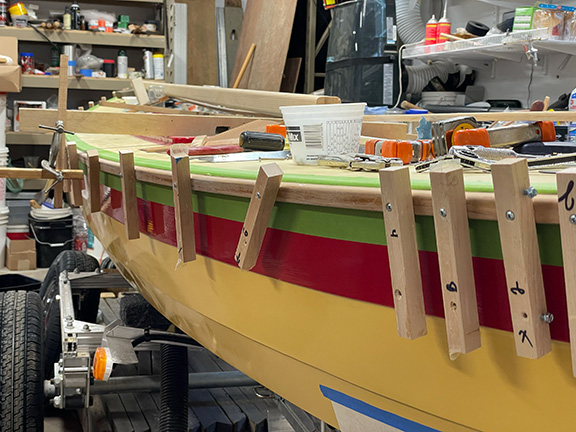
Both rubrails have been epoxied, bow ends shaped. Port side's dry-fitted here, maybe G-Flexed into permanent position once I've mowed the lawn today. Temp fasteners will be removed, then holes bored larger, black locust pegs epoxied in then cut & sanded flush. That way if I later want to replace the rails I can router them off with a piloted bit, leave maybe 1/8" as a base for new!
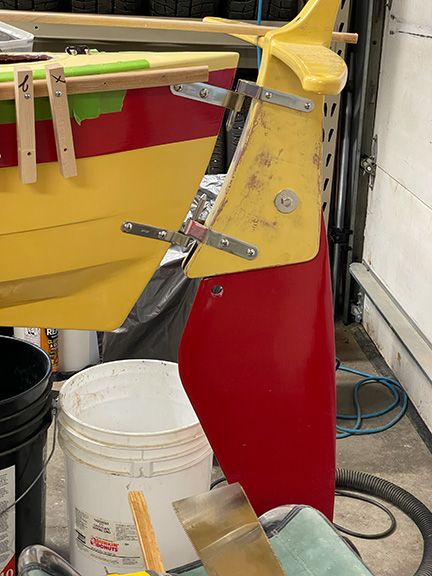
Rudder & cassette are assembled, fitted. Cassette needs more paint!
You others find any wear or friction where the rudder downhaul line passes between lower gudgeon pin tabs? It's not a straight path down there; I may cut a groove in the cassette's forward edge there to make a better lead. Or try a stainless screw eye perhaps. or maybe both!
Offline
#694 15 Jun 2021 6:39 am
- MartinC
- Member
- Registered: 3 Apr 2020
- Posts: 345
Re: Waterlust sailing canoe in Norway
Well done SP - Excellent progress!
I sanded a rounded groove in the cassette's forward edge with a Dremel. There is very little tension on the line so chafing shouldn't be a problem.
Offline
#695 15 Jun 2021 12:36 pm
- spclark
- Member
- From: "Driftless" Wisconsin USA
- Registered: 19 Mar 2020
- Posts: 478
Re: Waterlust sailing canoe in Norway
Thanks for that MartinC.
Jeff mentioned a time or two when his downhaul line got pinched down there, why I think a guide of sorts is worth the little effort it'd take to form one.
You shim your rudder too so it's not flopping side to side? There's about 3mm / 3/16" clearance on each side of my rudder that I've fashioned some big 'fender'-type washers out of 1/16" Delrin to take up. That the lower gudgeon mount needs T-nuts inside to thread its fasteners into makes some clearance necessary, but 3mm is quite a lot I think. Puts a lot of strain on the rudder at its bolt pivot.
Offline
#696 16 Jun 2021 10:13 am
- MartinC
- Member
- Registered: 3 Apr 2020
- Posts: 345
Re: Waterlust sailing canoe in Norway
Hi SP.
I don't think your proposals would do any harm, but beware having too tight a fit below the waterline. With weed, barnacles, expansion etc, in my experience, it doesn't do any harm to have a bit of play. I have known daggerboards/rudders get stuck down - which is a bit of a nightmare for a trailer sailer when it comes to recovering the boat!
Offline
#697 16 Jun 2021 11:51 am
- Bergen_Guy
- Member
- Registered: 6 Feb 2020
- Posts: 353
Re: Waterlust sailing canoe in Norway
I don't have any special fairing where the downhaul comes under the rudderstock, and then only issue I had with the whole downhaul setup was when I broke my lovely wooden eye at the top of the stock. I think I was pulling too hard while trying to get the rudder down - I think the uphaul got caught in it's jammer after I thought I had released it... anyway, I replaced that, and it's been fine ever since.
I too have quite a bit of play between rudder and stock, I don't notice that it 'flops about' when sailing really, and have left it as is. I figured that CLC have designed and sailed their boats enough to have come to a reasonably robust solution. When I made the rudder for the boys pram dinghy, I did reduce the gap a little over that in the CLC kit, but not by much, as I figured the issues that Martin mentions might start to cause problems.
Offline
#698 16 Jun 2021 12:44 pm
- spclark
- Member
- From: "Driftless" Wisconsin USA
- Registered: 19 Mar 2020
- Posts: 478
Re: Waterlust sailing canoe in Norway
Thanks both for your comments. You're right, I need to get this thing out of the garage and onto the water before I start changing things.
Port side's rubrail's nicely glued on (40 grams of G-Flex components rendered ~ 30 ml of mix; I had ~5 left over after getting the rail fixed in place with #8 sheet metal screws. Those came out after 7 hour cure @ 72-74°. I may add a couple of SS flatheads at each end for insurance.
Seems rudder downhaul can float outside cassette if it's left too slack when uphaul's taught. I'm wondering if simply fitting a small stainless steel pin between cassette cheeks down there would be enough to keep downhaul captive? Or a stainless screw eye....
Gotta go turn trailer & hull end for end before work. Not enough room to work on both sides with my wife's MINI garaged on her side of the 'boat shop'.
Offline
#699 16 Jun 2021 12:57 pm
- Bergen_Guy
- Member
- Registered: 6 Feb 2020
- Posts: 353
Re: Waterlust sailing canoe in Norway
The idea of a stainless pin between the cheeks sounds neat, or an eye strap (? not sure what they are called in the US!). Just enough to keep the line where it should be.
I know the problem with garage space. I have had the outriggers and crossbeam in for a few more coats of varnish (they only had one before the sea trials!) and then I want to get the hull back inside too so that I can strip back the paint on the skeg and bow, and fit the dynel tape re-enforcements. There seems always to be another small job to do!
Offline
#700 16 Jun 2021 4:20 pm
- spclark
- Member
- From: "Driftless" Wisconsin USA
- Registered: 19 Mar 2020
- Posts: 478
Re: Waterlust sailing canoe in Norway
Looking at my cassette & rudder yesterday after work it’s plain there’s precious little room for installing a ‘keeper’ made from a threaded fastener. My thinking now is simply a length of heavy-gauge solid copper wire (for fresh water only) across the opening would be sufficient.
Drill a small hole in each cassette cheek, insert straight wire between, secure with epoxy. For salt water use stainless steel, maybe a small nail. I have a box of Simpson brand ring-shank 1-3/4” nails from which I may use one after filing off the rings or covering them with a small length of HDPE plastic tubing to avoid chafe from the rings on that downhaul line.
Dry-fitted port side rub rail last night, need only to cut off overrun at stern then shape that end. Will G-Flex into place Saturday when I’ll have time to clean up any squeeze-out before it hardens fully.
Stepped main mast yesterday while I had hull out of garage to turn end-for-end. Pleased it’s as manageable as it is! that 20’ mast on my 14’ scow decades ago was heftier, always a struggle to step. This one’s absolutely no problem, at least with hull sitting on trailer’s bunks! I doubt I’d attempt it while on the water
Last edited by spclark (17 Jun 2021 12:03 pm)
Offline
